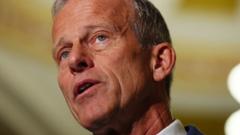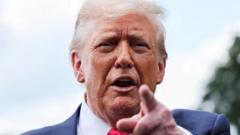Nike is responding to economic pressures by raising prices on some of its trainers and apparel, effective 1 June. This decision follows rival Adidas's warning of similar increases due to U.S. tariffs. Though Nike attributes the price adjustments to a mix of internal and external factors, the tariffs imposed by the Trump administration undoubtedly affect its business, especially given that most of Nike's merchandise is sourced from Asia.
Nike to Implement Price Increase Amid Tariff Instability

Nike to Implement Price Increase Amid Tariff Instability
Nike announces price hike on select products starting June 1, as tariffs and trade policies create uncertainty.
Beginning June 1, shoes priced above $100 will see price increases of up to $10, while clothing and equipment prices will rise by $2 to $10. Notably, popular items such as Nike’s Air Force 1 and products priced below $100 will be exempt from this adjustment, alongside children's collections and Jordan brand merchandise. In previous weeks, Adidas highlighted the impact of tariffs on its products, suggesting a broader trend among athletic brands.
The U.S. government has paused additional "reciprocal" tariffs until July, but a standing 10% base levy remains applicable to many imported goods, adding pressure on companies like Nike. The ongoing trade policy perils also create a challenging landscape for manufacturers, particularly those in Vietnam, which supplies a significant portion of Nike's products.
Interestingly, Nike has chosen to re-enter Amazon's marketplace after a hiatus of six years, attributing this move to declining online sales, where recent reports showed a drop across several global markets. As the sporting retail sector grapples with adjustments due to prevailing tariffs, Nike's pricing decisions reflect the complex interplay of manufacturing costs and market dynamics.
In response to these challenges, Nike will strategically navigate pricing, while competitors like Adidas take similar steps, suggesting a wider trend in the athletic wear industry.
As companies like Nike prepare for ongoing tariff implications, stakeholders and consumers alike will be watching closely to see how these pricing adjustments influence both demand and brand loyalty in the sporting apparel market.
The U.S. government has paused additional "reciprocal" tariffs until July, but a standing 10% base levy remains applicable to many imported goods, adding pressure on companies like Nike. The ongoing trade policy perils also create a challenging landscape for manufacturers, particularly those in Vietnam, which supplies a significant portion of Nike's products.
Interestingly, Nike has chosen to re-enter Amazon's marketplace after a hiatus of six years, attributing this move to declining online sales, where recent reports showed a drop across several global markets. As the sporting retail sector grapples with adjustments due to prevailing tariffs, Nike's pricing decisions reflect the complex interplay of manufacturing costs and market dynamics.
In response to these challenges, Nike will strategically navigate pricing, while competitors like Adidas take similar steps, suggesting a wider trend in the athletic wear industry.
As companies like Nike prepare for ongoing tariff implications, stakeholders and consumers alike will be watching closely to see how these pricing adjustments influence both demand and brand loyalty in the sporting apparel market.






















